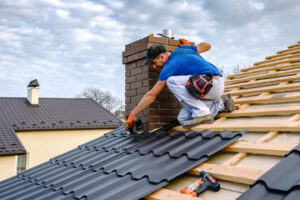What Does a Roofer Do?

Roofer builds, repairs, replaces, and maintains roofs for residential and commercial buildings. They use a variety of materials, including shingles and metal. They also attend meetings with salespeople and owners to discuss job plans and progress.

To become a roofer, you need to have occupational qualifications and experience. These can be obtained through college courses, an apprenticeship, or on-the-job training. Typical traits of roofers are that they are realistic individuals who prefer tasks that are physical, manual, and practical.
If you’re building a new house or replacing an existing roof, labor will make up the majority of your total cost. Typically, it will run around $2 per square foot of your new roof’s surface. This figure will increase or decrease depending on your roofing materials, roof pitch, and the removal of any existing materials. The average length of time it takes to complete the job will also impact your final cost. Military veterans are highly sought after in the roofing industry, as they often have a strong work ethic and are dedicated to finishing their projects. They’re also known for their ability to follow strict safety standards when working at heights.
If you’re interested in becoming a roofer, you can start by taking a four-year apprenticeship program. Once you’ve completed the required on-the-job training and technical education, you can get a journeyperson certificate. This will allow you to work as a roofer and shingler across Canada. Those who want to become certified can also take the Interprovincial Standards’ Red Seal exam.
Roofers inspect the structure of buildings and determine if they need repairs or maintenance. They also install and repair roofs using a variety of materials, such as bitumen and shingles. They’re also responsible for ensuring that all safety standards are followed on site. A good roofer can communicate with customers effectively and ensure that all projects are completed on time.
Roofers need to be physically fit and able to stand for long periods of time while working. They also need to be able to use hand tools and work on ladders or scaffolding. The job can be very dangerous, especially if you’re not used to working in high places. However, it can also be rewarding because you will see the results of your work every day. This can be quite motivating, compared to working in an office for a long period of time where you don’t have any tangible goals.
Insurance
Roofing is one of the most dangerous jobs in the construction industry. It’s a job where tiny errors can have drastic consequences, and many businesses find themselves in financial disaster after an accident. Luckily, roofing contractor insurance is available to help these businesses stay protected. It’s a bundle of individual policies that cater to the specific risks of this profession, and it may be legally required in some areas.
Generally, the main types of roofing insurance are general liability, workers’ compensation, commercial auto, and business owner’s policy (BOP). General liability protects your business when customers or third parties sue you for property damage. For example, if your employee accidentally damages a customer’s property while working on the roof, your general liability will cover the repairs and lawsuit awards. In addition, it will usually include coverage for damage caused by your employees using power tools, a potential fire hazard.
Workers’ compensation is a must for any roofing company with employees. It covers medical expenses and lost wages if your employee gets injured on the job. In some states, it’s also mandatory to pay into a state-run program that offers workers’ compensation coverage.
Errors and omissions insurance, or professional liability, is another important part of your roofing insurance package. It covers you if a client accuses you of shoddy work, even if the accusations are unfounded. If your employee damages a client’s car while driving to the job site, your business auto insurance will help cover the cost of repairs.
Finally, if your equipment is stolen or destroyed while it’s in transit between projects, you’ll want to consider an equipment floater for your roofing insurance package. This policy will cover the costs of repairing or replacing your tools and other equipment, regardless of where they are located. It also typically covers the cost of a rental vehicle while your equipment is being repaired or replaced.
Written Quote
A written quote is an agreement that outlines terms and conditions between the customer and the business. It should include information like the price, the services or products offered, the client’s responsibilities, and payment terms. This type of document provides more legal certainty than a verbal contract and ensures that all parties have agreed on the terms.
Using a quoting tool with customizable templates helps to maintain consistency and standardize the process. These tools also make it easier to create and track quotes and improve client accountability. For example, the client portal allows clients to view, comment on, and approve quotes within an expiration date.
Always remember to clearly label whether a document is an estimate or a quote. Estimates are only rough guides, while quotes are legally binding and should be used when you know the full costs involved.
